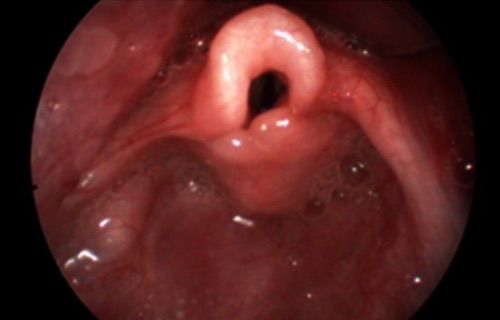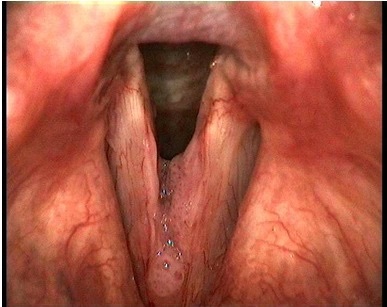Pediatric Surgery: Upper Airway Pathology
Proximal Upper Airway & Larynx
Choanal Atresia
- Congenital Posterior Nasal Passage Obstruction
- Presentation:
- Poor Suckling
- Intermittent Respiratory Distress
- Cyanosis – Worsens with Feeding, Improves with Crying
- Inability to Pass Nasal Tube
- May Be Associated with CHARGE Syndrome
- Coloboma of the Iris (Missing Part of the Iris)
- Heart Defects
- Atresia of the Choanae
- Retarded Growth
- Genitourinary Defects
- Ear Defects/Deafness
- Diagnosis: CT with Intranasal Contrast
- Tx: Endoscopic Transnasal Resection of Posterior Nasal Septum

Bilateral Choanal Atresia on CT 1
Laryngomalacia
- Soft Immature Supraglottic Cartilage Causes Collapse
- Most Common Cause of Airway Obstruction in Infants
- Presentation:
- Usually Presents at Birth
- Usually Resolves After 18-24 Months
- Symptoms:
- Inspiratory Stridor – Worsened by Supine Position
- Feeding Problems
- GERD
- Diagnosis: Flexible Laryngoscopy
- Treatment: Mostly Conservative Management
- Indications for Surgery:
- Life-Threatening Airway Obstruction
- Chronic Hypoxia
- Failure to Thrive
- Pulmonary Hypertension
- Cor Pulmonale
- Surgery: Supraglottoplasty (Microsurgery to Remove Redundant Tissue)
- Tracheostomy Was the Historical Procedure but Now Rarely Required
- Indications for Surgery:

Laryngomalacia on Laryngoscopy 2
Recurrent Respiratory Papillomatosis (Laryngeal Papillomatosis)
- Papillomas Due to Human Papillomavirus (HPV) Infection of the Upper Airway
- Most Common Larynx Tumor in Peds
- Source: HPV Positive Mother During Passage Through Birth Canal
- Commonly Resolves After Puberty
- Morbidity Can Arise from Obstruction
- May Require Laser Ablation or Laryngeal Shaving

Laryngeal Papillomatosis on Laryngoscopy 3
Trachea & Bronchi
Tracheomalacia
- Soft Immature Tracheal Cartilage Causes Collapse
- Most Outgrow by Age 18 Months
- Presentation:
- Expiratory Stridor
- Stridor May Be Inspiratory if Lesion is Extrathoracic in the Cervical Trachea
- Respiratory Distress
- Recurrent Respiratory Infections
- “Barking” Cough
- “Dying Spells” – Cyanosis, Apnea & Bradycardia Due to Severe Hypoxia After Feeding
- Expiratory Stridor
- Diagnosis: Dynamic Flexible Bronchoscopy
- See Elliptical Tracheal Rings
- Treatment: Mostly Conservative Management
- Indications for Surgery:
- Life-Threatening Airway Obstruction
- Chronic Hypoxia
- Failure to Thrive
- Surgical Options:
- Aortopexy (Suspend Aorta from the Sternum – Opening the Trachea)
- Tracheal Reconstruction
- Endoluminal Tracheal Stents
- Indications for Surgery:

Tracheomalacia, (a) Normal Trachea, (c) Tracheomalacia 4
Bronchiogenic Cyst
- Cystic Lesion of Bronchial Tissue
- Can Be Anywhere Along the Tracheobronchial Tree
- Usually Extrapulmonary
- Does Not Communicate with the Tracheobronchial Tree
- Cause: Abnormal Budding of the Foregut During Development
- Most Often Presents as a Young Adult
- Presentation:
- Recurrent Cough
- Recurrent Pneumonia
- Rapidly Enlarging Neck or Mediastinal Mass
- Filled with Thick Milky/Clear Fluid
- Cyanosis
- Respiratory Distress
- Tx: Surgical Excision
References
- Aksoy F, Demirhan H, Yildirim YS, Ozturan O. Bilateral choanal atresia in an adult – management with mitomycin C and without stents: a case report. Cases J. 2009 Dec 11;2:9307. (License: CC BY-2.0)
- Yee-Hang WB, Theresa H, So-Lun L, Wai-Kuen H, Ignace WW. Stridor in asian infants: assessment and treatment. ISRN Otolaryngol. 2012 Feb 19;2012:915910. (License: CC BY-3.0)
- Bohlender J. Diagnostic and therapeutic pitfalls in benign vocal fold diseases. GMS Curr Top Otorhinolaryngol Head Neck Surg. 2013 Dec 13;12:Doc01. (License: CC BY-NC-ND-3.0)
- Kamran A, Jennings RW. Wikimedia Commons. (License: CC BY-SA-4.0)